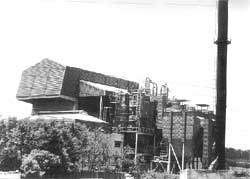A burning problem
 burning of household waste in one's backyard barrel may release more dioxins, furans and other chlorine-containing pollutants into the atmosphere than tonnes of trash burned by a municipal waste incinerator serving tens of thousands of homes. Furthermore, recycling could only make matters worse. Higher concentration of pollutants containing chlorine were created when recyclable materials were taken out of the waste mix and burnt compared with emissions when only household trash was burned.
burning of household waste in one's backyard barrel may release more dioxins, furans and other chlorine-containing pollutants into the atmosphere than tonnes of trash burned by a municipal waste incinerator serving tens of thousands of homes. Furthermore, recycling could only make matters worse. Higher concentration of pollutants containing chlorine were created when recyclable materials were taken out of the waste mix and burnt compared with emissions when only household trash was burned.
These are the findings of a study conducted by the us Environmental Protection Agency's Open Burning Test Facility in Research Triangle Park, North Carolina, usa.
According to Dwain Winters, director of the agency's Dioxin Policy Project, an estimated 20 million people in rural areas of the us burn trash in their backyards.And though emissions of dioxins and furans - two chemically similar groups of pollutants, which are considered possible carcinogens - vary considerably from barrel to barrel, backyard burning may contribute as much of these compounds to the air as all the nation's municipal waste incinerators combined.
"With improved pollution controls on incinerators, backyard burning may turn out to be one of the largest sources of dioxins and furans to the air," says Winters, adding: "We need a better understanding of barrel burning before we set policy on this source of air pollution."
The agency burned two 208-litre barrels filled with waste generated by a family that recycles (low in paper, glass, metal cans and certain plastics), and another two barrels filled with household trash. Hazardous materials like paint, solvents and oil were excluded.
The dioxins and furans released from the barrels were found to be approximately equal to the amount released from a 200 tonne per day municipal incinerator with well-functioning pollution controls. Such an incinerator handles garbage from 40,000 to 120,000 households.
Many factors influence the amount of dioxins and furans produced, including temperature, burn time, trash density and the presence of chlorine. Common materials containing chlorine include plastics, salt in food wastes and bleached paper products. The agency estimates that wood burned in fireplaces and stoves produces very small amounts of dioxins and furans compared with trash burned in barrels.
In the 1980's, one dioxin called 2,3,7,8-tetrachlorodibenzo-p-dioxin was considered one of most toxic compounds in the environment and was the cause for the evacuation and multimillion-dollar cleanup of Times Beach, Missouri, usa .
The project report is due to appear in the February 1, 2000 issue of Environmental Science & Technology .
Related Content
- Order of the National Green Tribunal regarding rise in air pollution in Delhi NCR due to stubble fires in Punjab and Haryana, 29/11/2023
- Establishing residue supply chains to reduce open burning: the case of rice straw and renewable energy in Punjab, India
- State Monitoring Committee report on solid waste management in Tamil Nadu, 24/05/2021
- Air quality in Thailand: Understanding the regulatory context
- Agro-Residue for Power: Win-win for farmers and the environment?
- Agro-Residue for Power
